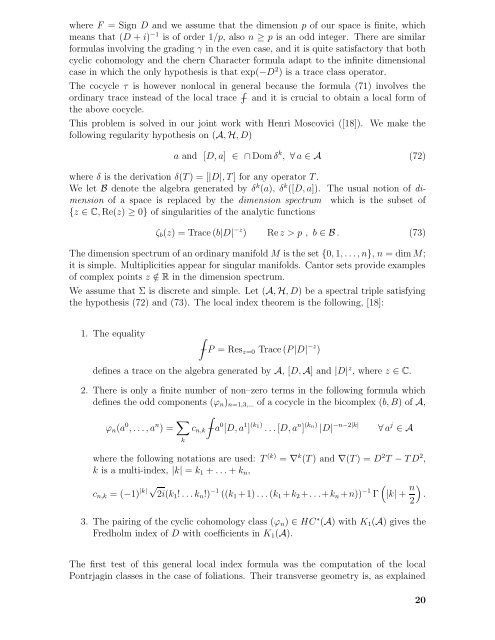Alain Connes (pdf)
Alain Connes (pdf)
Alain Connes (pdf)
You also want an ePaper? Increase the reach of your titles
YUMPU automatically turns print PDFs into web optimized ePapers that Google loves.
where F = Sign D and we assume that the dimension p of our space is finite, which<br />
means that (D + i) −1 is of order 1/p, also n ≥ p is an odd integer. There are similar<br />
formulas involving the grading γ in the even case, and it is quite satisfactory that both<br />
cyclic cohomology and the chern Character formula adapt to the infinite dimensional<br />
case in which the only hypothesis is that exp(−D 2 ) is a trace class operator.<br />
The cocycle τ is however nonlocal in general because the formula (71) involves the<br />
ordinary trace instead of the local trace ∫ − and it is crucial to obtain a local form of<br />
the above cocycle.<br />
This problem is solved in our joint work with Henri Moscovici ([18]). We make the<br />
following regularity hypothesis on (A, H, D)<br />
a and [D, a] ∈ ∩ Dom δ k , ∀ a ∈ A (72)<br />
where δ is the derivation δ(T ) = [|D|, T ] for any operator T .<br />
We let B denote the algebra generated by δ k (a), δ k ([D, a]). The usual notion of dimension<br />
of a space is replaced by the dimension spectrum which is the subset of<br />
{z ∈ C, Re(z) ≥ 0} of singularities of the analytic functions<br />
ζ b (z) = Trace (b|D| −z ) Re z > p , b ∈ B . (73)<br />
The dimension spectrum of an ordinary manifold M is the set {0, 1, . . . , n}, n = dim M;<br />
it is simple. Multiplicities appear for singular manifolds. Cantor sets provide examples<br />
of complex points z /∈ R in the dimension spectrum.<br />
We assume that Σ is discrete and simple. Let (A, H, D) be a spectral triple satisfying<br />
the hypothesis (72) and (73). The local index theorem is the following, [18]:<br />
1. The equality ∫<br />
−P = Res z=0 Trace (P |D| −z )<br />
defines a trace on the algebra generated by A, [D, A] and |D| z , where z ∈ C.<br />
2. There is only a finite number of non–zero terms in the following formula which<br />
defines the odd components (ϕ n ) n=1,3,... of a cocycle in the bicomplex (b, B) of A,<br />
ϕ n (a 0 , . . . , a n ) = ∑ k<br />
c n,k<br />
∫−a 0 [D, a 1 ] (k 1) . . . [D, a n ] (kn) |D| −n−2|k| ∀ a j ∈ A<br />
where the following notations are used: T (k) = ∇ k (T ) and ∇(T ) = D 2 T − T D 2 ,<br />
k is a multi-index, |k| = k 1 + . . . + k n ,<br />
c n,k = (−1) √ (<br />
|k| 2i(k 1 ! . . . k n !) −1 ((k 1 +1) . . . (k 1 +k 2 +. . .+k n +n)) −1 Γ |k| + n )<br />
.<br />
2<br />
3. The pairing of the cyclic cohomology class (ϕ n ) ∈ HC ∗ (A) with K 1 (A) gives the<br />
Fredholm index of D with coefficients in K 1 (A).<br />
The first test of this general local index formula was the computation of the local<br />
Pontrjagin classes in the case of foliations. Their transverse geometry is, as explained<br />
20

















